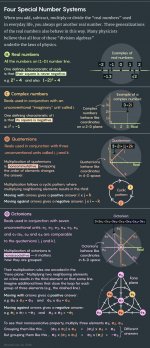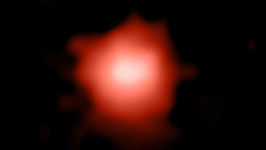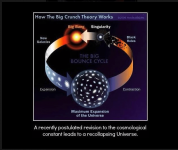That's heady stuff in your link, Steve, and would appear to boil down to the following:
Astrophysicists have to employ approximations when they use gravitational wave signals to calculate the masses of merging black holes.
The approximations are necessary because there is no simple or standard way of defining mass within the space-time of general relativity. It is the curvature of space-time that makes calculating the mass of a region in deep space so tricky - it's not as simple as standing on a set of scales in your bathroom!
I'll have to leave it at that. Truth be told, the only part I got near to understanding was Hawking mass, but that only applies to an idealised space-time.
https://en.wikipedia.org/wiki/Hawki...s is one,of space whose mass is to be defined.
Astrophysicists have to employ approximations when they use gravitational wave signals to calculate the masses of merging black holes.
The approximations are necessary because there is no simple or standard way of defining mass within the space-time of general relativity. It is the curvature of space-time that makes calculating the mass of a region in deep space so tricky - it's not as simple as standing on a set of scales in your bathroom!
I'll have to leave it at that. Truth be told, the only part I got near to understanding was Hawking mass, but that only applies to an idealised space-time.
https://en.wikipedia.org/wiki/Hawki...s is one,of space whose mass is to be defined.
That's heady stuff in your link, Steve, and would appear to boil down to the following:
Astrophysicists have to employ approximations when they use gravitational wave signals to calculate the masses of merging black holes.
The approximations are necessary because there is no simple or standard way of defining mass within the space-time of general relativity. It is the curvature of space-time that makes calculating the mass of a region in deep space so tricky - it's not as simple as standing on a set of scales in your bathroom!
I'll have to leave it at that. Truth be told, the only part I got near to understanding was Hawking mass, but that only applies to an idealised space-time.
https://en.wikipedia.org/wiki/Hawking_energy#:~:text=The Hawking energy or Hawking mass is one,of space whose mass is to be defined.
So you're saying you guess. 😀 Approximation, probability distribution, probabilistic wave function, Markov chain, sigma.. all cunning words designed to replace "I guess it's X" 😉
I took away the geometry on that link - essentially using the total surface to prove mass at infinity it's zero or positive.
I'm assuming because the previous maths used layers to measure it that they're expecting multiple roots within those layers. Although I may have confused myself 😀 I've seen geometrical simplification used before to solve some really nasty issues but right at this instant I need a hot drink.
This prompts me to ask what's an approximation, and how "inexact" does a figure have to be to be considered an approximation? We don't have the exact value of ANY physical constant, but we know some things a lot better than others.That's heady stuff in your link, Steve, and would appear to boil down to the following:
Astrophysicists have to employ approximations when they use gravitational wave signals to calculate the masses of merging black holes.
https://en.wikipedia.org/wiki/Gravitational_constantThe measured value of the [gravitational] constant is known with some certainty to four significant digits.
That's worse than I thought, maybe that's a different wording than when I saw the article before. At best it's known to 5 or 6 significant digits. Many of use have voltmeters that measure voltage with a better precision and accuracy than that.
What's also remarkable is where we were over 200 years ago:
The first implicit measurement with an accuracy within about 1% is attributed to Henry Cavendish in a 1798 experiment.https://en.wikipedia.org/wiki/Gravitational_constant#cite_note-3
I've always been fascinated by the Cavendish experiment. Gravity is so weak that no one would have thought of trying such a thing (everyday objects are attracted to the ground, but why would they be attracted to each other? The actual attractive force is much too low to be noticed without setting up such an experiment) without the cumulative knowledge of the physics of the Solar System and such developed over the previous 200 years.
But of course what the article is talking about (in terms of approximations) is much cruder, and astrophysicists are probably doing well to know these black hole masses to within (the article doesn't say, but I'm tossing out an, ahem, approximation...) 10 percent.
Anyone who is vaguely honest about the State of Physics today will admit the whole thing is a mess!

Standard Model is unable to cope with Gravity.
String Theory unable to predict anything.
Loop Quantum Gravity getting vague on detail.
What is the way forward?
I think it is the highest of the Clifford Algebras known as Octonions:
The fact it comes from the Light Blues at Cambridge further delights me. 🙂
Standard Model is unable to cope with Gravity.
String Theory unable to predict anything.
Loop Quantum Gravity getting vague on detail.
What is the way forward?
I think it is the highest of the Clifford Algebras known as Octonions:
The fact it comes from the Light Blues at Cambridge further delights me. 🙂
What is the way forward?
I think it is the highest of the Clifford Algebras known as Octonions
I've said it before, and I'll say it again. Steve certainly knows his onions! 😀
Attachments
Attached is a candidate for the most distant known galaxy, as imaged by the JWST.
This lensed galaxy has a measured redshift of 13 (hence its designation 'z13') which means we are seeing it as it existed 13.4 billion years ago, just 300 million years after the Big Bang.
In the time that has passed since the image we see of it, cosmic expansion has carried z13 farther away from us, and today it is over 32 billion light-years away from us - far beyond where any telescope can reach!
Full spectroscopic analysis will follow to confirm the exact redshift.
The full story is here: https://www.space.com/james-webb-space-telescope-most-distant-galaxy
This lensed galaxy has a measured redshift of 13 (hence its designation 'z13') which means we are seeing it as it existed 13.4 billion years ago, just 300 million years after the Big Bang.
In the time that has passed since the image we see of it, cosmic expansion has carried z13 farther away from us, and today it is over 32 billion light-years away from us - far beyond where any telescope can reach!
Full spectroscopic analysis will follow to confirm the exact redshift.
The full story is here: https://www.space.com/james-webb-space-telescope-most-distant-galaxy
Attachments
Not really - I think that galaxy took the opposite way of us, thus the distance between us is now 2*age of universe... 🙂
Nice picture of the circular economy.... but
//
are you trying to say we’ve been excreted and left on the cosmic side walk? 😱🤣
A selection of raw Webb data is being made publicly available to amateur imagers such as Judy Schmidt.
Using processing tools, including Photoshop, Judy is producing her own images based on the Webb data.
The attachments show Judy's image of M74, the Phantom Galaxy, in comparison to a Hubble image of the same galaxy.
Using processing tools, including Photoshop, Judy is producing her own images based on the Webb data.
The attachments show Judy's image of M74, the Phantom Galaxy, in comparison to a Hubble image of the same galaxy.
Attachments
However you look at it, the Universe is only ever marvelous to us. Imagine if it was only as big as our Solar system and we see no stars...or only as big as our orbit around the Sun!
Imagine if it was only as big as our Solar system and we see no stars...or only as big as our orbit around the Sun!
Funnily enough, Pete, the Universe was the radius of the Earth's orbit when it was was about a trillionth of a second old.
That certainly takes a bit of imagination!
And you would indeed "see no stars" as they didn't start forming until the Universe was 50-100 million years old.
Yes I realize that...if that's how you believe the universe came to be. But I mean the prospect of my suggestion being all there is outside of ourselves. Brings Jim Carey to mind.Funnily enough, Pete, the Universe was the radius of the Earth's orbit when it was was about a trillionth of a second old.
That certainly takes a bit of imagination!
And you would indeed "see no stars" as they didn't start forming until the Universe was 50-100 million years old.
But imagine if the non-existent transitional fossil record is simply a parallel/testament to the unchanging laws of physics and life/existence as we observe it is all there is and all there ever was anywhwere and we came here..or more probably were brought here due to our natural inclination to outsmart ourselves having destroyed our previous location. So the pre-historic life present here was anilhilated for our sake because it is an otherwise suitable habitat. This would satisfy the notion of technological advancement and the Fermi Paradox, we being the epitome of all that is or will ever be, the climax. What could possibly exceed the ability to consciously observe and contemplate existence?
disappointed? 😢
what if it's true?
- Status
- Not open for further replies.
- Home
- Member Areas
- The Lounge
- What is the Universe expanding into..






